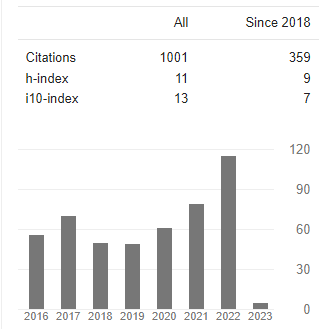AN ASSOCIATION OF RUNNING SPEED WITH SELECTED ANTHROPOMETRIC VARIABLES IN SCHOOL GOING BOYS
Abstract
The purpose of the study were to find out the correlations between running speed with selected anthropometric variables, namely, height, height weight ratio (HWR), total leg length, total arm length, thigh girth, calf girth, biceps girth, foot length and chest circumference. For this purpose a total of 500 normal, healthy school-going boys aged 10-17 years were selected randomly from different schools of CoochBehar district, West Bengal, India. Anthropometric measurements were taken using standard tools and equation and running speed was measured by 50 yard dash test. Mean and Standard deviation were calculated for each variable as descriptive statistics and Coefficient of Correlation was measured by Pearson’s Product Moment Method using standard statistical software. The significance level was set for the present study was only 0.05 level of confidence. The findings of the present study indicated a strong association of running speed with all the anthropometric variables in school going boys considered for the present project. From the findings it may be concluded that running speed has more strong and significant association with the standing height, total leg length and total arm length in school going boys. Running speed has also strong and significant relationship with chest circumference, thigh girth, calf girth, biceps girth and foot length but not significant relationship with HWR. Results also revealed that the height, total arm length and total leg length should be considered as the best predictor of running speed than others variables in school going boys.
Downloads
References
Cavagna, G. A.; Saibene, F. P.; Margaria, R. (1964). "Mechanical Work in Running". Journal of applied physiology 19: 249–256.
Corbin, C. B. (1976), Physical fitness of Children, In: C B Corbin (Ed): A Text Book of Motor Development. Iowa: Wm. C. Brown Company, pp. 77-82.
Cratty, B. J. (1975), Movement Behaviour and Motor Learning, Philadelphia: Lea and Febiger.USA.
D’Hondt, E. Deforche, B. De Bourdeaudhuij, I. and Lenoir, M. (2009), Relationship between motor skill and body mass index in 5- to 10-year-old children, Adapt Phys Activ Q., Vol.26, No.1, pp: 21-37.
Dhaliwal, S. S. (1990), Physical fitness of 10 – 18 years old males living at two selected altitudes, Doctorial Thesis, Pnajabi University, Patiala.
Fogelholm, M. Stigman, S. Huismsn, T. Metsamuuronen, J. (2008), Physical fitness in adolescents with normal weight and overweight, Scand J Med Sci Sports, Vol.18, No.2, pp: 162-170.
Halme, T. Parkkisenniemi, S. Kujala, U.N. and Nupponen, H. (2009), relationship between standing broad jump, shuttle run and Body mass index in children aged 3 to 8 years, The Journal of Sports Medicine and Physical Fitness, Vol.49, No.4;PP:395-400.
Hayward, V. H. and Stolarczyk, L. M. (1996), Applied body composition, Champaign, I. L: Human Kinetics, pp.143-144.
Hunsicker, P. and Greey, G. (1957), Studies in Human Strength, Research Quarterly, Vol.28, pp: 109-122.
Jones, H. E. (1949), Motor Performance and Growth, Berkeley: University of California Press.
Milanese, C. Bortolami, O. Bertucco, M. Verlato, G. and Zancanaro, C. (2010), Anthropometry and Motor fitness in children aged 6-12 years, Jurnal of Human Sporta and Exercise, Vol. 5, No. 2; pp: 265-279.
Sohi, A. S. (1986), A study of development of speed and agility among 6 – 14 years of boys and girls, Snipes Journal, Vol.9, No.3, pp: 16-23.















